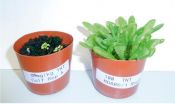Increased odds for type 2 diabetes after prenatal exposure to Ukraine famine of 1932-33
2015-09-03
(Press-News.org) September 3, 2015 - Men and women exposed in early gestation to the man-made Ukrainian Famine of 1932-33 in regions with extreme food shortages were 1.5 times more likely to be diagnosed with Type 2 diabetes in adulthood. In regions with severe famine there was a 1.3 fold rise in the odds of Type 2 diabetes, and there was no diabetes increase among individuals born in regions with no famine.
Researchers at Columbia University's Mailman School of Public Health, the Komisarenko Institute of Endocrinology and Metabolism in Kiev, Ukraine, and the Cheboratev Institute of Gerontology in Kiev are the first to conduct a large-scale study of the relationship between famine severity during different stages of prenatal development and Type 2 diabetes risk. Findings are online in the Lancet Diabetes and Endocrinology.
Scientists have long known that poor living conditions around the time of birth may have long-lasting effects on health. For Type 2 diabetes, they suspected that nutrition in pregnancy was a possible explanation but studies with reliable measures of the severity and timing of under-nutrition in pregnancy in large representative populations were not yet available.
The new Lancet study included all 43,150 cases of Type 2 diabetes diagnosed at age 40 or over in the Ukraine national diabetes register between 2000-2008. The researchers matched these records with all 1.4 million individuals in the 2001 census who were born in the selected regions between1930-1938 and still alive in the year 2000.
"The most important finding of our study is the dose-response relation between the severity of famine exposure in early gestation and the likelihood of later diabetes," said L.H. Lumey, MD, Mailman School of Public Health associate professor of Epidemiology and the study's first author.
Data for the years 1932-1934 show that the odds for diabetes were highest and the birth counts lowest in early 1934, nine months after famine mortality peaked between May to July 1933. Using month of birth, the researchers identified early gestation as a timeframe that appears to be particularly sensitive to long-term effects of prenatal famine. They were able to quantify the impact of prenatal famine on Type 2 diabetes in men and women, accounting for region of birth, seasonal effects, and their possible interactions. Results were the same for both sexes.
According to the researchers, the relation between season of birth and Type 2 diabetes was likely related to seasonal differences in food availability. The authors point out that deficiencies of a low-calorie diet most likely worsen during the winter and spring when food stocks from the previous harvest are depleted. "We show that the strong season of birth effects on late life diabetes among individuals born in the years 1930-1938 in all Ukraine regions were substantially larger for births in the first half year of 1934 in famine regions, especially after famine in early gestation," noted Lumey.
"Epigenetic changes in DNA regulation in early nutrition could provide a causal link with long-term health outcomes but need further investigation ' said Lumey. "Our findings to date are very exciting however, and further expand previous insights on the importance of the early gestation period gained from famine studies in other settings. "
A Commentary article in the same issue of The Lancet Diabetes and Endocrinology by Harvard Professor Matthew W. Gillman notes that the study had a large sample size, reasonably precise information about the timing of the famine, geographical variation in the same country, and clinical outcomes - a combination of strengths missing in other famine studies. Findings "raise the possibility that the first trimester of pregnancy holds crucial clues about the development of diabetes in offspring later in life."
INFORMATION:
The study was funded by the Ukraine State Diabetes Mellitus program (0106U000844) and the National Institutes of Health (RO1 AG-028593). The authors declare no conflicts of interest.
About Columbia University's Mailman School of Public Health
Founded in 1922, Columbia University's Mailman School of Public Health pursues an agenda of research, education, and service to address the critical and complex public health issues affecting New Yorkers, the nation and the world. The Mailman School is the third largest recipient of NIH grants among schools of public health. Its over 450 multi-disciplinary faculty members work in more than 100 countries around the world, addressing such issues as preventing infectious and chronic diseases, environmental health, maternal and child health, health policy, climate change & health, and public health preparedness. It is a leader in public health education with over 1,300 graduate students from more than 40 nations pursuing a variety of master's and doctoral degree programs. The Mailman School is also home to numerous world-renowned research centers including ICAP (formerly the International Center for AIDS Care and Treatment Programs) and the Center for Infection and Immunity. For more information, please visit http://www.mailman.columbia.edu
ELSE PRESS RELEASES FROM THIS DATE:
2015-09-03
MADISON, Wis. -- "Gaydar" -- the purported ability to infer whether people are gay or straight based on their appearance -- seemed to get a scientific boost from a 2008 study that concluded people could accurately guess someone's sexual orientation based on photographs of their faces.
In a new paper published in the Journal of Sex Research, researchers at the University of Wisconsin-Madison challenge what they call "the gaydar myth." William Cox, an assistant scientist in the Department of Psychology and the lead author, says gaydar isn't accurate and is actually a harmful ...
2015-09-03
The gut is an important reservoir for drug-resistant bacteria responsible for life-threatening hospital-acquired infections. A study in mice published on September 3rd in PLOS Pathogens reports that two of the most common antibiotic-resistant bacterial species circulating in hospitals occupy and effectively share the same location in the gut, and that they can be eliminated by fecal transplantation of a healthy gut microbiome.
Eric Pamer, from Memorial Sloan-Kettering Cancer Center in New York, USA, and colleagues, investigated the interactions between vancomycin-resistant ...
2015-09-03
Much like birds fly in flocks to conserve energy, dolphins swim in pods to mate and find food, and colonies of ants create complex nests to protect their queens, immune cells engage in coordinated behavior to wipe out viruses like the flu. That's according to a new study published today in the journal Science by researchers at the University of Rochester School of Medicine and Dentistry.
The findings reveal, for the first time, how immune cells work together to get to their final destination - the site of an injury or infection. The body is expansive and a virus or bacteria ...
2015-09-03
WASHINGTON, DC (September 3, 2015)-- The District of Columbia's needle exchange program prevented 120 new cases of HIV infection and saved an estimated $44 million over just a two-year period, according to a first-of-a-kind study published today by researchers at the Milken Institute School of Public Health (Milken Institute SPH) at the George Washington University.
"Our study adds to the evidence that needle exchange programs not only work but are cost-effective investments in the battle against HIV," says Monica S. Ruiz, PhD, MPH, an assistant research professor in ...
2015-09-03
Why are there not more lions when there's plenty of prey on the African savanna?
A research team including two University of Guelph ecologists has discovered an unexpected pattern linking prey and predator species in diverse ecosystems worldwide.
Integrative biology professors John Fryxell and Kevin McCann co-authored the paper, published today in Science. The team included researchers at McGill University, the University of British Columbia and the Perimeter Institute for Theoretical Physics in Waterloo, Ont.
Beyond lions and the gazelles they hunt on the African ...
2015-09-03
This news release is available in Japanese.
Regular exposure to bacteria particles and farm dust protects children from allergies because it blunts their inflammatory immune responses, a new mouse study suggests. The study implicates a particular anti-inflammatory enzyme, A20, in this protective effect. While aspects of how allergies develop remain unclear, scientists know they're driven not only by genes but also by environment. Homes with pets, as well as dairy farms - where children breathe dust containing higher doses of fungal particles, cowshed-derived bacteria ...
2015-09-03
This news release is available in Japanese.
Ecological communities around the world are richly varied, but a new study finds that many of these diverse communities follow an unexpected, yet consistent pattern: where prey are abundant, there are not proportionally more predators. Instead, as prey biomass increases, the ratio of predator-to-prey biomass decreases. This pattern was systematically identified across different areas, including grasslands, forests, lakes, and oceans, revealing an underlying structural organization of ecosystems. Pinpointing underlying ...
2015-09-03
This news release is available in Japanese.
Researchers have identified a mutation in plants that allows them to break down TNT, an explosive that has become highly prevalent in soil in the last century, particularly at manufacturing waste sites, mines, and military conflict zones. TNT, or 2,4,6-trinitrotoluene, is a toxic and persistent environmental pollutant that accumulates in the roots of plants, inhibiting growth and development. The identification of a plant mechanism that not only evades the negative impacts of TNT, but breaks down this harmful substance could ...
2015-09-03
This news release is available in Japanese.
A special news edition, Science in Iran, looks closely at the scientific challenges and triumphs of a country that has faced international isolation in recent years. Following an exclusive interview about the Iran nuclear deal with Ali Akbar Salehi, president of the Atomic Energy Organization of Iran, Science International News Editor Richard Stone delves further into the state of Iran's scientific endeavors. Decades of economic sanctions have deprived Iranian scientists of critical scientific resources and collaboration. ...
2015-09-03
Biologists at the University of York have taken an important step in making it possible to clean millions of hectares of land contaminated by explosives.
A team from the Centre for Novel Agricultural Products (CNAP) in the University's Department of Biology has unravelled the mechanism of TNT toxicity in plants raising the possibility of a new approach to explosives remediation technology. TNT has become an extensive global pollutant over the last 100 years and there are mounting concerns over its toxicity to biological systems.
The study, which is published in Science, ...
LAST 30 PRESS RELEASES:
[Press-News.org] Increased odds for type 2 diabetes after prenatal exposure to Ukraine famine of 1932-33




